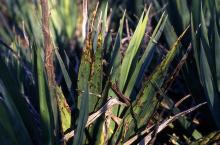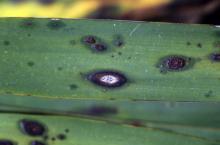Cause Coniothyrium bartholomaei, a fungus, has been found on yucca in Oregon. Cladosporium herbarum (formerly Mycosphaerella tassiana) and Kellermania yuccifolia have been reported from Washington. Phaeosphaeriopsis obtusispora (formerly Paraphaeosphaeria obtusispora), which has a Coniothyrium anamorph, has been reported for both Oregon and Washington. Generally, weather or irrigation that keeps leaves wet for extended periods favors the disease.
Symptoms Coniothyrium-small spots start out purple but become zoned with a center that turns light grayish brown. Concentric rings of tiny, black, fruiting bodies (pycnidia) develop in the spots. Spots generally are 1 inch or more in diameter and have a purple border. They coalesce on severely infected leaves, which eventually die. Generally more severe on lower portion of the plant.
Cultural control
- Keep lawn irrigation off leaves or water such that leaves are not wet for extended periods.
- Remove and destroy infected leaves.
Chemical control Use in the spring during new leaf growth.
- Bonide Copper Fungicide at 8 oz/3 gal water. Group M1 fungicide. H
- CuPRO 5000 at 1.5 to 5 lb/A. Group M1 fungicide. 48-hr reentry.
- Monterey Liqui-Cop at 3 Tbsp/gal water. H
- Nu-Cop 50 DF at 1 lb/100 gal water. Group M1 fungicide. 48-hr reentry.
- Protect DF at 1 to 2 lb/100 gal water plus 2 to 4 oz spreader-sticker. Group M3 fungicides. 24-hr reentry.
- Spectro 90 WDG at 1 to 2 lb/100 gal water. Group 1 + M5 fungicide. 12-hr reentry.



